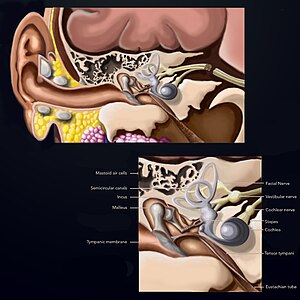Ear ossicles
| Ossicles | |
|---|---|

|
|
| Details | |
| Identifiers | |
| Latin | Ossicula auditus, ossicula auditoria |
| MeSH | A09.246.397.247 |
| Dorlands /Elsevier |
Ossicles |
| TA | A02.1.17.001 |
| FMA | 52750 |
|
Anatomical terms of bone
[]
|
|
The ossicles (also called auditory ossicles) are three bones in either middle ear that are among the smallest bones in the human body. They serve to transmit sounds from the air to the fluid-filled labyrinth (cochlea). The absence of the auditory ossicles would constitute a moderate-to-severe hearing loss. The term "ossicle" literally means "tiny bone" and, though the term may refer to any small bone throughout the body, it typically refers to the malleus, incus, and stapes (hammer, anvil, and stirrup) of the middle ear.
The ossicles are, in order from the eardrum to the inner ear (from superficial to deep): the malleus, incus, and stapes, terms that in Latin are translated as "the hammer, anvil, and stirrup".
Studies have shown that ear bones in mammal embryos are attached to the dentary, which is part of the jaw. These are ossified portions of cartilage—called Meckel's cartilage—that are attached to the jaw. As the embryo develops, the cartilage hardens to form bone. Later in development, the bone structure breaks loose from the jaw and migrates to the inner ear area. The structure is known as the middle ear, and is made up of the stapes, incus, malleus, and tympanic membrane. These correspond to the columella, quadrate, articular, and angular structures in the amphibian, bird or reptile jaw. For this reason, researchers believe that mammals and reptiles share a common ancestry.
...
Wikipedia
